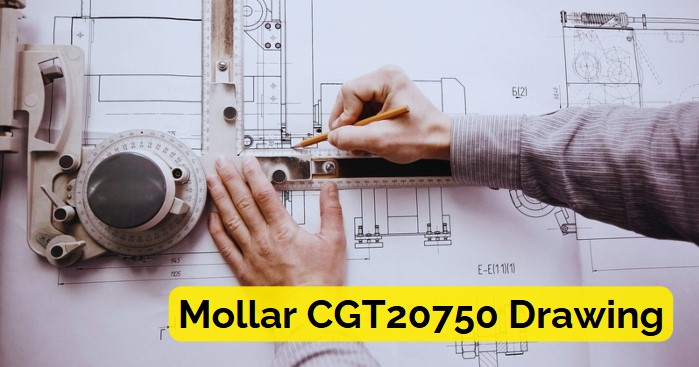The Mollar CGT20750 Drawing is essential in technical design and manufacturing. It acts as a precise blueprint for creating products, ensuring that every design aspect is accurate. Whether you are an experienced engineer or a beginner, understanding this drawing will significantly improve your workflow and outcomes.
This article explores the Mollar CGT20750 Drawing, covering its history, components, uses, and best practices. By the end, you’ll gain a solid understanding of its value and how to utilize its details across different industries.
What is the Mollar CGT20750 Drawing?
The Mollar CGT20750 Drawing defines the specifications for a product, structure, or system. It includes detailed measurements, material descriptions, and assembly instructions that guide engineers and manufacturers through production.
Typically, this drawing exists as a CAD (computer-aided design) file, featuring 2D projections, isometric views, and sometimes 3D renderings. It also includes annotations, such as dimensions, tolerances, and materials, which help ensure accuracy during production. Mastering these elements is crucial for anyone involved in design or manufacturing.
Historical Background of the Mollar CGT20750 Drawing
Mollar has a rich history in engineering and design, and the CGT20750 drawing stands out as one of its flagship models. The company initially focused on drafting tools before evolving into a leader in technical drawings. Mollar introduced the CGT20750 drawing to improve manufacturing precision.
The Mollar CGT20750 has undergone several updates, with each iteration enhancing its clarity and usability. As CAD technology became mainstream, Mollar transitioned to digital designs, allowing for greater flexibility and precision. This shift transformed how industries use these drawings, improving efficiency and reducing errors.
Key Components of the Mollar CGT20750 Drawing
To fully understand the Mollar CGT20750 Drawing, you must familiarize yourself with its key components, including:
- Title Block: This section contains project metadata, such as the drawing number, title, and revision.
- Views and Projections: These provide various perspectives of the product, including front, side, and top views. Some drawings also include isometric or exploded views.
- Dimensions and Tolerances: These detail the exact size of parts and their permissible variations.
- Materials and Surface Finish: This section lists the materials used and any required finishes.
These components ensure that every aspect of the design is communicated clearly and accurately.
Also Read: Fibord Handmade Stainless Steel Sink K30-1
How the Mollar CGT20750 Drawing is Used in Different Industries
The Mollar CGT20750 Drawing plays a significant role in various industries, such as engineering, construction, automotive, aerospace, and manufacturing. In engineering, it offers a detailed roadmap for building mechanical parts, ensuring accuracy throughout the production process.
Within automotive manufacturing, engineers use the drawing to design components such as engine parts or transmission systems, minimizing defects. In construction, designers can use the drawing to create complex structures, like bridges or high-rise buildings. Similarly, aerospace manufacturers rely on the drawing to meet safety standards for aircraft parts.
The Significance of Accuracy in the Mollar CGT20750 Drawing
Accuracy is crucial when working with the Mollar CGT20750 Drawing. A small error in interpreting or applying the drawing can lead to significant issues, such as faulty components or product failure. Ensuring precise measurements, dimensions, and tolerances is essential for successful production.
Tolerances can sometimes be difficult to understand. While dimensions provide exact measurements, tolerances specify the range of acceptable variation. Properly understanding these variations ensures that parts fit together as intended, preventing costly mistakes.
Understanding the Symbols and Notations Used in the Drawing
The Mollar CGT20750 Drawing uses standardized symbols and notations to convey important design details. These symbols enable engineers to communicate complex information quickly and clearly, regardless of language barriers.
Common symbols include those for materials, surface finishes, and welding methods. For example, a welding symbol might specify the type of weld required, such as a butt weld or fillet weld. Similarly, material symbols indicate whether the part is made from stainless steel, aluminum, or another material.
Being familiar with these symbols is essential when interpreting the drawing, as they provide insights not always explicitly written out.
Tools and Software for Working with the Mollar CGT20750 Drawing
When working with the Mollar CGT20750 Drawing, the right tools are crucial. CAD software like AutoCAD, SolidWorks, and CATIA are commonly used to create and edit these drawings. These programs provide precision, flexibility, and the ability to easily revise designs.
In addition to CAD software, engineers use hardware tools such as digital calipers and micrometers for measurement. 3D printers are also helpful for creating prototypes that adhere to the drawing’s specifications, ensuring that the design translates effectively from digital to physical form.
Troubleshooting Common Issues with the Mollar CGT20750 Drawing
Working with the Mollar CGT20750 Drawing can present challenges. Misinterpreting dimensions or tolerances can lead to parts that don’t fit correctly. To avoid these errors, it’s crucial to understand the acceptable variations for each measurement.
Another issue can arise when the drawing is unclear or poorly drafted. In such cases, you must clarify any ambiguities with the design team before proceeding. Mismatches between the drawing and the physical prototype can also occur if material or surface finish details are vague or overlooked.
Ensuring that all specifications are clearly communicated and understood can help prevent these issues.
Conclusion
The Mollar CGT20750 Drawing is an invaluable tool in design and manufacturing. It provides a detailed, accurate guide for creating high-quality products. Mastering its components, symbols, and best practices is vital for anyone working with technical drawings.
By understanding and utilizing the Mollar CGT20750 Drawing, engineers and manufacturers can achieve better project outcomes, higher precision, and fewer errors. For further learning, exploring resources on CAD software, industry-specific applications, and technical drawing standards will enhance your knowledge and skills.
